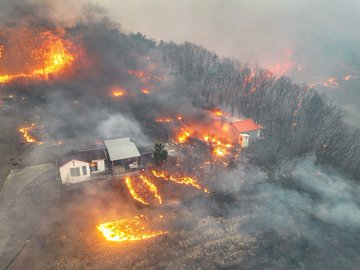Blazes fueled by strong winds have consumed vast areas, destroying over 200 structures and forcing mass evacuations.
At least 24 people have died, and thousands have been displaced as wildfires continue to sweep through South Korea’s southern regions.
The fires, driven by powerful winds, have consumed over 43,330 acres (17,535 hectares) of land, forcing the evacuation of 27,000 people and destroying homes, factories, and an ancient Buddhist temple.
Among the casualties was a helicopter pilot who died on Wednesday when his aircraft crashed while battling the flames in Uiseong, one of the worst-affected areas.
The fires, which began last Friday, have burned through several southeastern cities and towns, including Andong, Uiseong, Sancheong, and Ulsan.
In Uiseong, the flames devastated nearly half of the structures at Gounsa Temple, originally built in the seventh century.
Two state-designated national treasures—an ornate pavilion from 1668 and a Joseon Dynasty structure from 1904—were damaged, though an eighth-century stone Buddha statue was safely relocated.
In Cheongsong, authorities evacuated 500 inmates from a detention center as a precautionary measure, though no damage was reported at the facility.
South Korea’s Ministry of the Interior raised the wildfire warning to its highest level, requiring local governments to deploy emergency personnel, tighten access to forests and parks, and suspend military live-fire exercises.
The death toll includes four firefighters and government workers who perished on Saturday in Sancheong after being trapped by fast-moving flames. More than 20 others have sustained injuries.
Government officials suspect human activity may have triggered some of the blazes.
Investigators are looking into reports that fires may have started from sparks caused by welding equipment or traditional grass-clearing practices near family tombs.
More than 4,650 firefighters, soldiers, and emergency personnel have been deployed to contain the wildfires.
However, strong winds and dry conditions continue to make firefighting efforts difficult.
Observers have described the ongoing disaster as the third-largest wildfire in South Korea’s history in terms of land consumed.
As authorities work to contain the blazes and assess the full extent of the damage, the affected communities are left grappling with the destruction left in the fires’ wake.

















